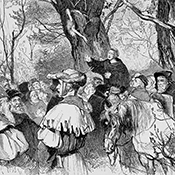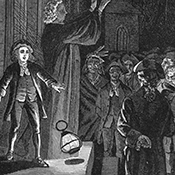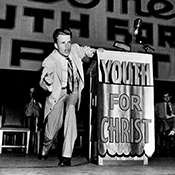Although we may not think of the church as a powerful and effective user of new media today, Christians in the early church all the way through the 1960s were powerfully leveraging technology for the sake of the Gospel:
-

In the 16th century, Martin Luther used brand new printing methods to create pamphlets, woodcuts, and tracts that ended up in the hands of millions across Europe, fueling the Reformation.
-

Over 200 years later, famous preacher George Whitefield used a secular media empire—owned by his close friend Benjamin Franklin—to organize revival meetings and disseminate copies of his sermons throughout the Western World, fueling the First Great Awakening.
-

In the 20th century, Billy Graham pioneered TV and radio programming to reach a live audience of over 200 million people and hundreds of millions more around the world, fueling the modern evangelistic crusade.
Historically, Christians have not only leveraged new media, but pioneered it in order that every person may hear the message of Christ.
Read more about how Luther used brand new technology to pave the way for the Reformation.
Read moreHow Luther and Whitefield Went Viral
It is hard to imagine a disillusioned German monk as the first viral celebrity five centuries before the advent of the internet, but the title is likely well-earned. Before anyone else, Martin Luther seized upon the potential of the printing press—the massive media innovation of his day—to spread news of the Gospel throughout Germany and Europe. Within the first decade of the Reformation, some six to seven million pamphlets were printed, more than a quarter of them Luther’s. This is all the more remarkable given that Luther was a little-known monk in an inconspicuous part of Germany. Yet thanks to his connections with printers, writes Luther's friend Friedrich Myconius, “hardly 14 days had passed when these propositions [95 Theses] were known throughout Germany and within four weeks almost all of Christendom was familiar with them1.”
Luther saw the potential not only of the printing press, but also of social networks to spread his message. Unlike many of his Catholic counterparts, Luther wrote in German instead of Latin and published visually illustrated pamphlets instead of books. Like YouTube videos, Instagram photos, or blog posts, Luther’s pamphlets were intended to be shared. They were short, illustrative, and designed to be printed quickly and passed from hand to hand. At many points during the Reformation, Luther published a new pamphlet every day. The result: they spread like wildfire through hundreds of small printing shops across Europe, shaping the collective thought of millions.
Luther leveraged and adapted the media technologies of his day to propel the Gospel message, and it went viral. Historian Andrew Pettegree sums up the interrelation of Luther and the printing press this way: “Printing was essential to the creation of Martin Luther, but Luther was also a determining, shaping force in the German printing industry2.”
Two hundred years later at the beginning of the 18th century, we see a very similar virality propel the First Great Awakening. The early American colonies were going through their own media revolution driven by the advent of newspapers. Newspapers were inexpensive, quickly printed, written by local communities, and commanded impressive circulation in America’s growing cities. They promised to connect with the reading public daily. Innovator Benjamin Franklin quickly saw this potential and pioneered new partnerships with newspapers so that popular articles could be printed across all the colonies overnight.
George Whitefield, the famous preacher of the Great Awakening, forged a close partnership with Franklin. Whitefield leveraged Franklin’s new media empire as well as pushing its boundaries. Thanks to Franklin’s publicity, Whitefield preached to audiences of over 20,000—the largest recorded gatherings in early American history. Franklin’s press covered the news of Whitefield’s events as he travelled from town to town. Perhaps most importantly, newspapers reprinted hundreds of the best revival sermons, which were then read and delivered to congregations across the colonies. Newspapers united the colonies under the same revival preaching, fueling America’s First Great Awakening.
According to Randy Peterson, “Whitefield and Franklin were the most famous men in 18th century-America: the printer and the preacher3.”
Both Luther and Whitefield saw the importance of seizing media innovations for spreading the Gospel. Each forged partnerships with media players, created unique and compelling content designed to be shared, and were unabashed in promoting that content for God’s glory.
References:
1 http://www.economist.com/node/21541719
2 Andrew Pettegree, Brand Luther.
3 Randy Peterson, The Printer and the Preacher.
Today, it is easier than ever to disseminate a message instantly to anyone in the world who has internet access. Via Facebook alone, it is possible to communicate with nearly 30 percent of the world’s population.
Monthly Active Social Media Users


What would Paul, Marty, George, and Billy do?
If you could tell historic church leaders that they could reach millions to billions of people who don’t know Jesus with the good news, we’re pretty sure they would find a way to do it. Yet, in our research, we observed that the digital presence of most Christian ministries, churches, and brands (including those aimed towards answering “seeker questions”) was actually targeted towards Christians.
We believe the church can do better.
While it is great to encourage the faithful, we also need to focus on using our resources and platforms to share the good news of Jesus in a thoughtful, engaging way with youth, who are highly active media consumers.
Generation Z’s Media Use shows that they are truly digital natives:
-
The average Gen Z’er spends nine hours a day on social media.Source: Common Sense Media
-
YouTube is by far the most popular platform for entertainment, with 94% of Gen Z’ers using it monthly.Source: BPI
-
Only 2% of all people on Twitter follow a religious leader, house of worship, or pastor.Source: Grey Matter Research
How Can I Help?
The world of digital media holds unprecedented opportunities for the spread of the Gospel. Of course, there are challenges: Digital and social media can tend towards truncated communication, information overload, fake identities, echo chambers, and shallow relationships. We don’t find any of this surprising. We’ve uploaded our sin along with our ideals, yet in some ways the Gospel message shines all the brighter.
Digital media is an inescapable part of our world and a growing influence among our youth. Inspired by the examples of Luther, Whitefield, and Graham, we think it’s time to foster the kind of innovation that caused the Gospel to advance through the media channels of those earlier eras. For a deeper exploration of ways to take action, download the report.
- Pastors and
Lay-Leaders - Church
Members - Funders and
Ministry Leaders
Does my church have a high-quality website and an engaging online presence in other online platforms, and an easy way to connect online visitors to actual people?
How can my church interact with its community digitally, and how can I bring more young people into leading that work?
How can I teach my church members—particularly younger digital natives—to engage online in ways that are thoughtfully informed by their faith?
How am I engaging my community through my testimony and the Good News, digitally and offline?
How could I help my church improve its digital presence?
Who is one person I can pray for who doesn’t know Jesus?
How could I contribute to the creation of a strong, outward-facing brand targeted at the unaffiliated?
What would it mean to invest in a studio that produces high-quality multimedia content to reach the unaffiliated through social networks?
How can I help create thoughtful social media resources for Christian pastors and leaders?
What are ways to help address the growing need for local churches to improve their online presence?
